Minerva Kerr Stuart 'Victory': Conversion to Lambton Colliery version
Originator: David L. O. Smith
I have collated this write-up on my website at:http://www.davidlosmith.co.uk/KerrStuartVictoryNo41.htm
Well-wishers (at least, I suppose they are) have enquired if I am alright as I seem to have stopped building 7mm models. Well, not to worry, I am still building.
Until a few weeks ago, I was ‘doing battle’ with a kit of Hudswell Clarke industrial 0-6-0DM on the forum, NCB ‘David No. 58. My wife bought me one of the prototype’s nameplates as a birthday present so, to build a 7mm model to go with it, seemed like a good idea … but it’s now finished and is waiting in the paint shop … that might be the subject of another story, if there's any interest.
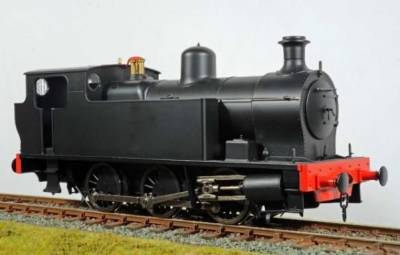 A perfectly good RTR Victory class loco
A perfectly good RTR Victory class loco
Anyway, as many of you may know, I seem unable to buy a RTR loco and just run it so I have reduced a Kerr Stuart 'Victory' by Minerva Model Railways to a kit of parts to rebuild it as the one of the class that worked on the Lambton Hetton & Joicey Colliery Railway and that had its cab 'rounded off' to enable it to work down the narrow bored tunnel to Lambton Drops (coal staithes) at the Port of Sunderland. No. 41 no longer exists but the cab of No. 29, an 0-6-2T built by Kitson and Company of Leeds in 1904, was similarly profiled and it is preserved on the North Yorkshire Moors Railway.
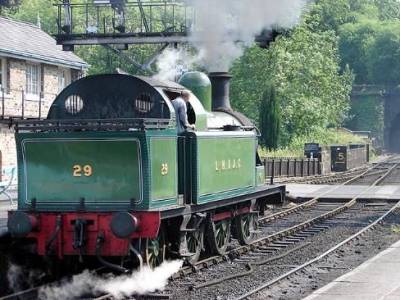 No. 29 on the North Yorkshire Moors Railway
No. 29 on the North Yorkshire Moors Railway
As one of the last two of the Victory class to be built, No. 41 did not have the thick wooden buffer planks in front of the steel ones like the others in the class and as modelled by Minerva. It seemed to me to be more psychologically sound to make the replacement buffer beams before I set to with the miller to remove the perfectly good ones.
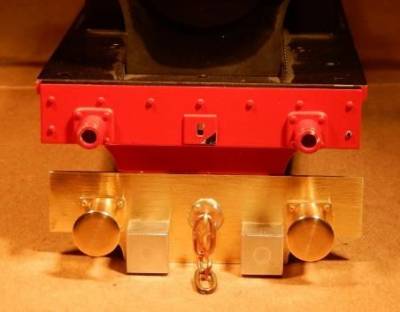 I was able to reuse the buffer heads and shanks (I slightly reduced the diameter of the former and made some collars to increase their diameter of the latter) but I made new buffer stocks, drawplates and I reworked the coupling with more accurate hooks and links.
I was able to reuse the buffer heads and shanks (I slightly reduced the diameter of the former and made some collars to increase their diameter of the latter) but I made new buffer stocks, drawplates and I reworked the coupling with more accurate hooks and links.
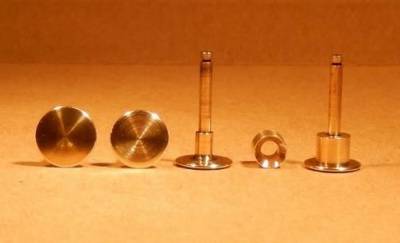 Head reduced in diameter (left) and diameter of shank increased with collar (right)
Head reduced in diameter (left) and diameter of shank increased with collar (right)
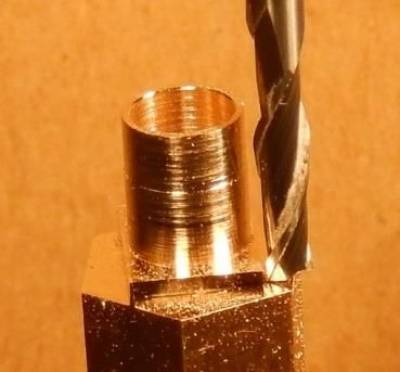 An embryo buffer shank appearing from a piece of hex brass bar (because I have many such off-cuts)
An embryo buffer shank appearing from a piece of hex brass bar (because I have many such off-cuts)
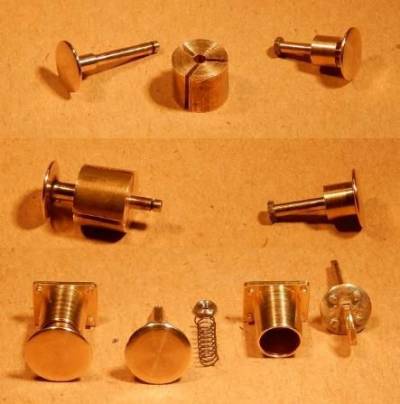 Holding the buffer shanks using a bespoke split collet to reduce their length
Holding the buffer shanks using a bespoke split collet to reduce their length
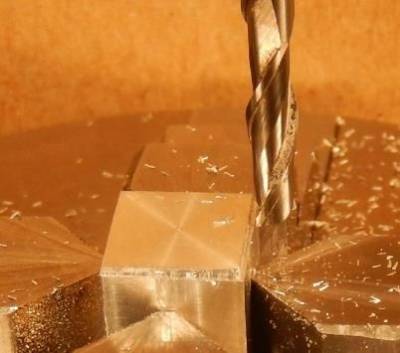 Milling a representation of the steel plate that faces the dumb buffer
Milling a representation of the steel plate that faces the dumb buffer
Next time … … removing the old buffer beams and fitting the new.
Quentin - Fascinating David!
I too am modifying a Minerva Victory, but mine is to one of the two purchased by the North Staffs. and taken on by the LMS at grouping. However, my modifications are much more basic than yours, involving a lot of 'plastic bashing' rather than metal work. The biggest problem for mine is the boiler/smokebox/firebox is completely different to the Minerva version. I shall show pics. of mine when finished, when all the flaws are concealed by paint and weathering!
I shall follow your version with interest.
Quentin
DLOS - Thank you, Quentin.
Now, I have had to do some plastic-bashing as well. It makes little difference to me but, as the running plate was metal, I built the new buffer plank assemblies in metal too. However, I worked in plastic when I went through a similar exercise with my Hudswell Clarke 0-6-0ST by Ixion Model Railways because its running plate was plastic.
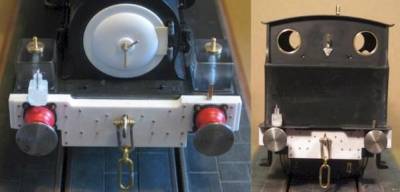 Pictures of your WIP are allowed, you know; don't feel that you have wait until you have completed your conversion! I have not been able to find an image from a quick Google search to see what you're up against; are you able to provide a link, please?
David
Sandell10466 - David
Do you mean it will be like this one? (but I am sure yours will be much better.) This one is from a etched kit by Pete Stamper (Agenoria ?)with a scratch built cab roof just modeled from photographs. Photo taken on St Georges Pit, which is not my railway, but is listed in the website list of layouts.
Pictures of your WIP are allowed, you know; don't feel that you have wait until you have completed your conversion! I have not been able to find an image from a quick Google search to see what you're up against; are you able to provide a link, please?
David
Sandell10466 - David
Do you mean it will be like this one? (but I am sure yours will be much better.) This one is from a etched kit by Pete Stamper (Agenoria ?)with a scratch built cab roof just modeled from photographs. Photo taken on St Georges Pit, which is not my railway, but is listed in the website list of layouts.
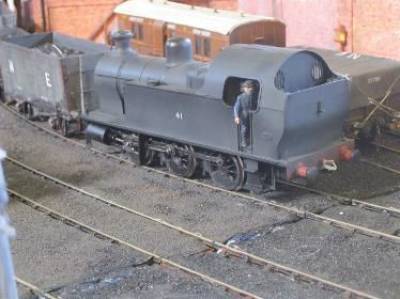 Mike S.
ThomasHeller - David,
extremely stunning work!!! I really appreciate those step by step photos! What have you made the bolts on the buffers from?
Thomas
Mike S.
ThomasHeller - David,
extremely stunning work!!! I really appreciate those step by step photos! What have you made the bolts on the buffers from?
Thomas
DLOS - Mike Sandell Yes, indeed, that' the one, although I intend to finish mine in the original ornate LH&JCR livery.
Thomas Heller Thank you, Thomas. I made the simulated bolts on the buffer stocks from round brass wire. I did think about hex, and I've done it before, but this was simple and will be effective enough, I am fairly sure.
With this all at hand, for a second time I milled off perfectly good representations of buffer planks and buffers (for the first time see: [URL='http://www.davidlosmith.co.uk/GCR_Humber.htm#BufferPlanks']www.davidlosmith.co.uk/GCR_Humber.htm#BufferPlanks[/URL]).
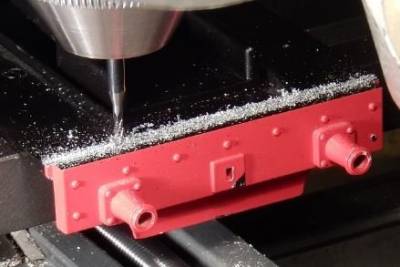 I attached the new front buffer plank with steel pins and epoxy resin to the machined end of the diecast running plate.
I attached the new front buffer plank with steel pins and epoxy resin to the machined end of the diecast running plate.
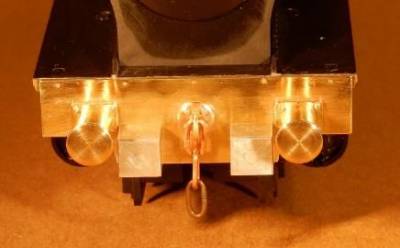 To allow for the thinner buffer plank, the running plate is extended under the bunker at the rear. I represented this by laminating some waste etches, as I had no suitable brass stock of the correct hickness, and I milled the edges to match the existing running plate. I then soldered the new rear buffer plank to the extension piece and screwed and glued the assembly to the running plate.
To allow for the thinner buffer plank, the running plate is extended under the bunker at the rear. I represented this by laminating some waste etches, as I had no suitable brass stock of the correct hickness, and I milled the edges to match the existing running plate. I then soldered the new rear buffer plank to the extension piece and screwed and glued the assembly to the running plate.
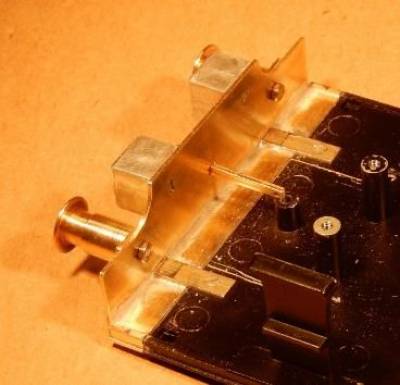
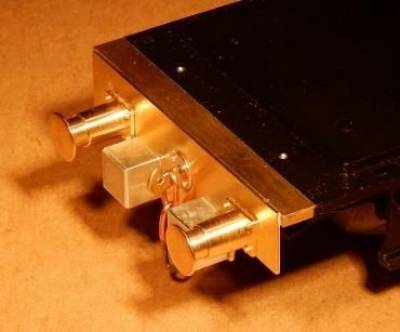
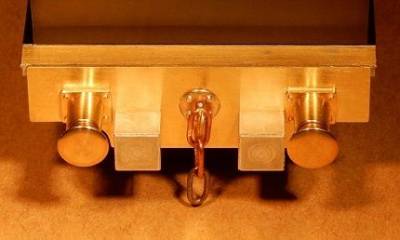
DLOS - The chimney is a rather prominent feature of a steam loco so, as contributes greatly to its ‘character’, I set about modifying the existing chimney. The upper part is a brass turning and is easily removed with a twist and a pull, whereas the lower part (the flared base) is moulded integrally with the smokebox. The several photographs that I had of this LH&JC loco all showed a chimney with a quite different profile (below) but with a secondary flange between the flare and the smokebox.
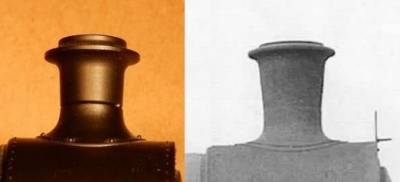 Chimneys: model (left]) and No. 41 (right)
I reckoned that, by removing most of the flare on the model, what remained would represent the flange. I set up the smokebox moulding in a chuck on the rotary table and, in the time honoured fashion of twiddling the right handles in the right order by the right amount, I milled away all but about 0.5mm of the lower part of the chimney.
Chimneys: model (left]) and No. 41 (right)
I reckoned that, by removing most of the flare on the model, what remained would represent the flange. I set up the smokebox moulding in a chuck on the rotary table and, in the time honoured fashion of twiddling the right handles in the right order by the right amount, I milled away all but about 0.5mm of the lower part of the chimney.
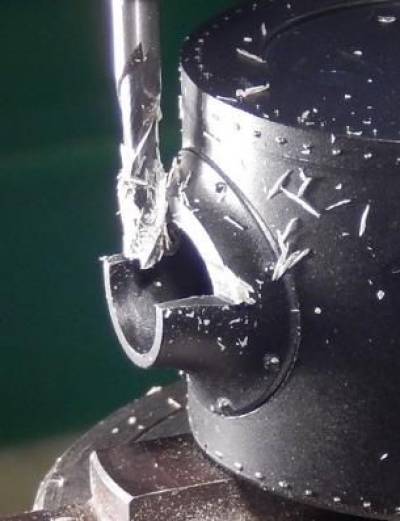 Milling away the integrally moulded flare to leave a flange
Milling away the integrally moulded flare to leave a flange
I could have machined a replacement chimney but making the flare requires a fair amount of tedious work with a file (I do know, I have done it) so I decided to use the flare from a white metal chimney casting that I had to hand and to turn an upper part to fit it.
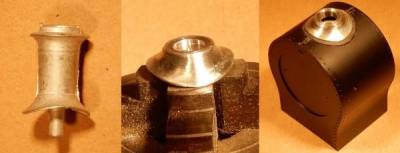 White metal casting (left), machined flare (centre) and flare placed on the flange (right)
White metal casting (left), machined flare (centre) and flare placed on the flange (right)
Less than twenty four hours after I had reached this point, a friend emailed me an image of No. 41 in its original LH&JC livery, just as I wished to model it. Yes, this is what good friends are for: the image clearly showed that, at the time, No. 41 still had its more elegant Kerr Stuart chimney.
Now read on …
I visited my good friend a few days later so I was able to thank him for the image that he had sent and to explain what I’d done. Now this was what good friends are for: he gave me a replacement white metal casting for the chimney and also one for the dome, which very neatly solved another problem that I had spotted early on.
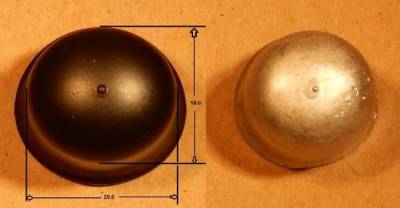 Oval plastic dome (left) and replacement circular white metal casing (right)
Oval plastic dome (left) and replacement circular white metal casing (right)
The plastic dome on the model (left, above) is perfectly formed and clips very neatly into the boiler to give a very good representation of a sheet metal dome sitting on sheet metal boiler cladding. The problem is that, although perfectly formed, the main body is far from circular; it is 18.0mm front to back (as it should be) but 20.0mm from side to side, which is rather noticeable. My friend’s donated white metal casting needed a bit of filling with low melt solder and a bit of fettling but it is very nearly a uniform 18.0 mm in diameter.
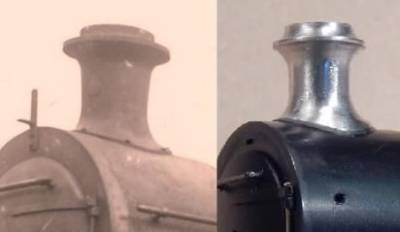 Chimneys: prototype (left]) and model (right)
Chimneys: prototype (left]) and model (right)
Although the replacement chimney is a fair representation of that of the prototype, I must concede that it is not as faithful as the original integral moulding and brass turning but I did not consider it worth altering and/or adapting its base to take the brass turning.
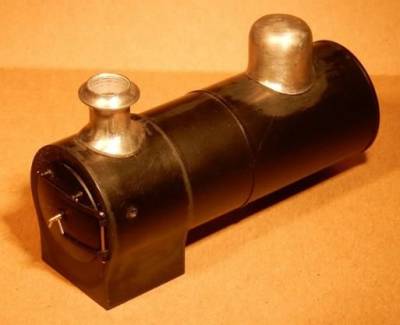 I blanked off the hole left by the dome with 0.5mm plastic card and I screwed both castings in place with nuts on studs that I soldered into the castings. I used epoxy resin to blend in the flare of the chimney casting with the integral flange and then cleaned it up.
I blanked off the hole left by the dome with 0.5mm plastic card and I screwed both castings in place with nuts on studs that I soldered into the castings. I used epoxy resin to blend in the flare of the chimney casting with the integral flange and then cleaned it up.
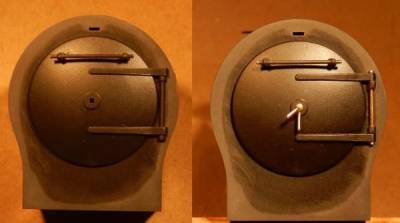 Smokebox door before (left) and after (right)
Smokebox door before (left) and after (right)
As with the buffer planks, the smokebox on No. 41 was fabricated with flush rivets so I sanded off the snap head representations that were moulded on the model. I moved the door hinges (smokebox parts between the door parts) and made up a headed nickel silver pin to replace the integral moulding. I made the door handle/darts as three simple turnings and soldered them together into an assembly that fits in the central hole in the door. More to follow …
The safety valves are well depicted in a plastic moulding but I decided to make up new ones in brass. I should make it clear at this point that this replacement is not intended as a criticism of this excellent RTR model but is merely my choice; there is a great deal of difference between what may be tackled in a modeller's workshop and what may be achieved at a very reasonable price on a production run.
The valve casings are simple turnings, a turned down 12BA thread represents a square-section spring and I filed the handle from a piece of nickel silver. To solder the four components together, I assembled them in a little jig that held the two casings and the spring at the correct distances to fit in the holes that I had drilled in the cover on the firebox.
 Original plastic mouldings (left), jig for assembling the replacements (centre) and the final replacement assembly (right)
Original plastic mouldings (left), jig for assembling the replacements (centre) and the final replacement assembly (right)
In reality, the safety valves do not sit on top of the cover on the firebox, the cover fits over them; I milled a slot in the cover to represent this so that the valves appear to be coming through the cover rather than sitting on top of it.
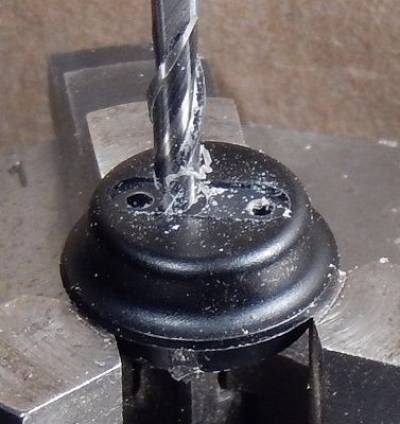 More to follow …
More to follow …
Ian - This feature is usually ignored, or may not be known about, by most modellers. It is nice to see someone else showing the slot through which the valve stems fit. At the painting stage it is worth putting some black paint in the slot to represent the void. Ian.
DLOS - I tackled the cylinders and the rods next.
The cylinder covers on the prototype are retained by twelve rather prominent bolts or screws whereas the covers on the model are provided with eighteen small representations, which I removed and replaced with inserts of styrene rod.
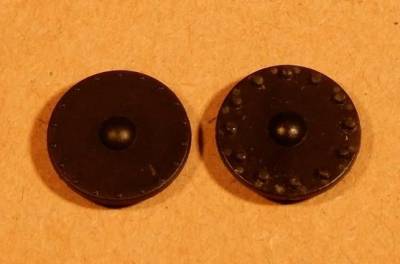 Cylinder cover before (left) and after (right)
Cylinder cover before (left) and after (right)
The diecast rods on the model are finished in shiny nickel plating and they do benefit from a bit of fettling with a file to remove moulding lines and the draft. In doing this, I removed the nickel and underlying copper plating to reveal the base metal, which looks rather more like steel than the nickel plating.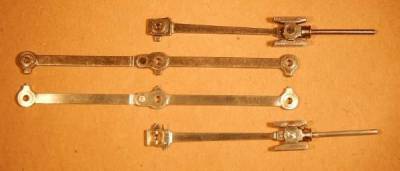 Coupling rods and conrods before (above) and after fettling and with additions (below)
Coupling rods and conrods before (above) and after fettling and with additions (below)
I took the opportunity to add ‘brasses’, a cotter and retaining screws (on the big end), a cotter on the crosshead (to retain the piston rod) and to replace the gudgeon pin and knuckle joint pin with something a little more realistic.
The slidebars are similarly finished in shiny nickel and they also benefit from cleaning up by draw filing. The prototype has two oil pots on the upper slide bar and both slide bars are attached to the motion bracket with a bolts through a rectangular block. These small component are easily machined … if you can just get hold of them. I used the convenient expedient of a solder chuck: solder the blank to a mandrel, machine the component, unsolder it from the mandrel.
 Machining an oil pot. The mandrel with a hole and a turned blank with a spigot (left), the blank soldered to the mandrel (centre) and machining the blank (right)
Machining an oil pot. The mandrel with a hole and a turned blank with a spigot (left), the blank soldered to the mandrel (centre) and machining the blank (right)
The motion plates are painted black but are etched from nickel silver so I stripped them of paint, tinned them all over and then stroked them with a Garryflex abrasive block to represent steel.
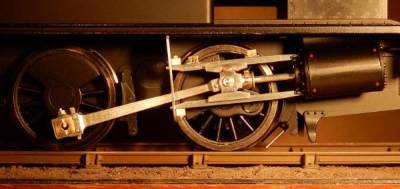 Reworked conrod, crosshead, slidebars and cylinder
The fillers for the sand boxes have the traditional lids with a handle above a recess and this is represented in half relief in the die cast footplate but it seems to be reversed from what would be expected (ie the surround and handle are depressions and the recess is two raised nearly semi-circles). I decided to machine away these impressions with a 3/16” slot drill and to make replacements that projected slightly above the footplate, as they appeared in my photograph.
Reworked conrod, crosshead, slidebars and cylinder
The fillers for the sand boxes have the traditional lids with a handle above a recess and this is represented in half relief in the die cast footplate but it seems to be reversed from what would be expected (ie the surround and handle are depressions and the recess is two raised nearly semi-circles). I decided to machine away these impressions with a 3/16” slot drill and to make replacements that projected slightly above the footplate, as they appeared in my photograph.
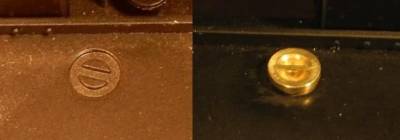 Half relief sandbox lid (left) and machined replacement (right)
Half relief sandbox lid (left) and machined replacement (right)
The process was quite simple, if a bit delicate. First, I turned a piece of stock brass to diameter and made the depression with a bull nose slot drill. I then transferred the job to the milling machine and milled two short slots (0.5mm wide, 0.25mm deep) in the rim, working outwards from the depression, to accept the handle. I made the handle from a short length of 0.5mm diameter brass wire, which I soldered into the two shallow slots. As half the diameter is above the original turning, I had only to return the job to the lathe and very carefully, with light cuts and a slow feed, remove half the diameter of the wire to leave a semi-circular (half-round) handle.
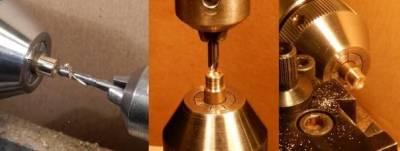 Partway through machining the depression (left), milling the shallow slots to accept the wire handle (centre) and machining away the outer half of the wire (right)
Partway through machining the depression (left), milling the shallow slots to accept the wire handle (centre) and machining away the outer half of the wire (right)
I was never taught these skills because I did not go to the sort of school where one was expected to do anything useful, such as go on to use one's hands, and it was not part of my training as an engineer (Chartered Engineer, but retired now) so I taught myself. I acknowledge that I grew up with a father with an excellent workshop, so I gained the philosophy of workshop practice, but he wanted me to be taught properly - I was never sure where he thought that would be by the 1960/70s. David
Jim Snowdon - Very much the same in my case. My father, also a Chartered Engineer, had a reasonably equipped workshop, and I suspect he learned his skills from his father, who was a Colliery Engineer in Durham. I learned by observation and trying things out to the point where I first encountered machine tool training, as a trainee with GEC Traction, I was entirely at home on virtually any machine tool, including some lathes far bigger than anything we will ever need as modellers. The only thing I never mastered was the art of grinding lathe tools, but fortunately these days the availability of tools with replaceable carbide inserts has effectively solved that.
The important part is starting off with decent machines capable of doing the job without being under stress, not the smallest you think you can get away with. I have a Warco WM180 lathe, which is large enough to handle the smaller end of model engineering, but entirely capable of making couping rod bushes, and a Proxxon FF250 vertical mill, which is large enough, but not by much. The rest is really down to acquiring the skill, which can only be done by doing things. Jim
SharpStewart - Well executed work, especially the extension of the running plate mounting for the rear buffer beam
I was greatly intrigued with the compressible brass collet sleeve, slotted almost through to the bore, and look forward to trying this soon as a variation to the more usual single slot cut right into the bore.
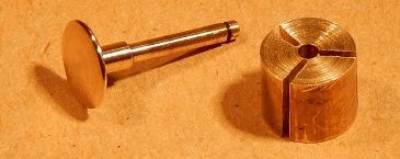 DLOS - It only works if one of the slots goes all the way through to the bore.
David
DLOS - It only works if one of the slots goes all the way through to the bore.
David
SharpStewart - David,
On closer inspection, it does look as though one of the slots does enter the bore . However, it's very probable that even if it didn't, the thin membrane remaining at the end of each slot would compress to allow clamping. I will try it out of interest! It's not unlike the way “System 3R Miniblock” workholders function in industry.
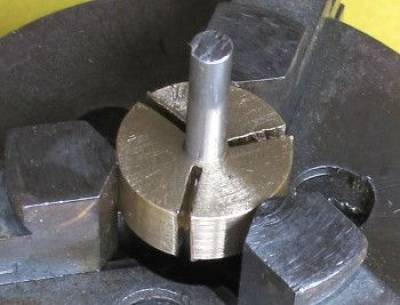 Well I just tried it, ;) with a piece of 1/8“ silver steel (in a reamed hole). It does clamp up, but I'm not sure there's too much of a practical benefit over the normal method of having one of the slots cut through into the bore. Theoretically, it could enhance concentricity - and anyone needing to turn down shaft ends to make jig axles or ball joints 'might' benefit.
Anyway, it was a concept that intrigued me when I imagined I first saw it in DLOS' posting. :)
Stewart
Well I just tried it, ;) with a piece of 1/8“ silver steel (in a reamed hole). It does clamp up, but I'm not sure there's too much of a practical benefit over the normal method of having one of the slots cut through into the bore. Theoretically, it could enhance concentricity - and anyone needing to turn down shaft ends to make jig axles or ball joints 'might' benefit.
Anyway, it was a concept that intrigued me when I imagined I first saw it in DLOS' posting. :)
Stewart
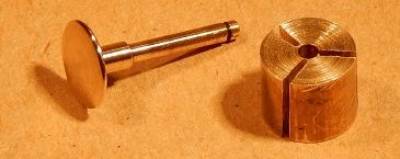 DLOS - Yes, the cut at the three o'clock position goes all the way through to the bore. Looking at this image now on public display, I am rather ashamed of the crudeness of the collet! Had I known, I would have set it up in the miller and cut the slots more carefully with a slitting disc but, as it was, I cut them by hand with a hacksaw because I just wanted to move on with it.
I concur with Jim, Graham and David re getting on with it, learning as you go, trying ever more challenging jobs, making things other than parts for model railways, how much more informed (connected?) we are these days, and the benefit of acquiring ideas and stock from other disciplines.
Thank you all for your kind words.
David
I have been having difficulty photographing my replacement sandbox lids but I have tried again:
DLOS - Yes, the cut at the three o'clock position goes all the way through to the bore. Looking at this image now on public display, I am rather ashamed of the crudeness of the collet! Had I known, I would have set it up in the miller and cut the slots more carefully with a slitting disc but, as it was, I cut them by hand with a hacksaw because I just wanted to move on with it.
I concur with Jim, Graham and David re getting on with it, learning as you go, trying ever more challenging jobs, making things other than parts for model railways, how much more informed (connected?) we are these days, and the benefit of acquiring ideas and stock from other disciplines.
Thank you all for your kind words.
David
I have been having difficulty photographing my replacement sandbox lids but I have tried again:
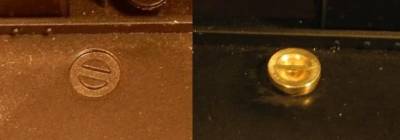 Half relief sandbox lid (left) and machined replacement (right)
Half relief sandbox lid (left) and machined replacement (right)
It's still not brilliant but it does give a better idea. I think part of the problem is that my camera cannot expose for the bright brass fabrication and the matt black running plate, but it's having trouble with focussing, too. David
Quentin - At last I have finished my conversion of the Victory into the LMS (ex NSR Class KS) shunting tank. My conversion was basic compared with yours David, and was intended to give an impression of the prototype NSR Class KS tank in LMS days. I had thought that a 'few tweaks' would suffice, but as with most projects I found that a lot of work would be necessary, complicated by a lack of a suitable drawing. The changes I have made have all been 'estimated' from photos of the prototype compared with the Minerva drawing and the model itself. The prototype was a class of just 2 locos inherited by the LMS from the North Staffs., who in turn bought them from KS in 1919 from a cancelled order from Argentina.
The main alterations I have made to the Minerva model are: new smokebox and firebox, combined with a lowering of the boiler and new chimney, lowered safety valves and repositioned whistle, remodelling of the bunker shape and addition of coal rails, new front footsteps, various handrails, etc., etc. The revised model is a 'representation' of the prototype rather than an exact 'scale' model. Hopefully the photos will illustrate the outcome.
Quentin
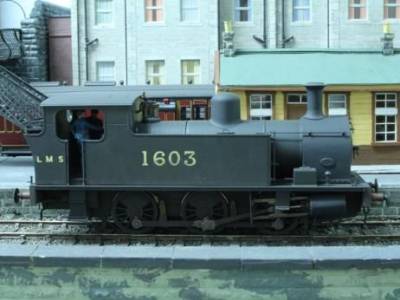
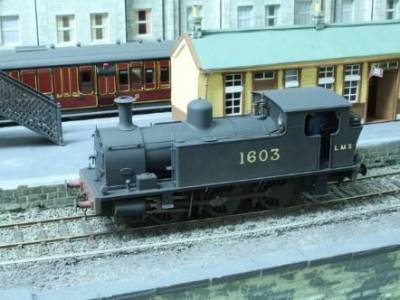 DLOS - Brilliant, Quentin!
Yes, I often start out thinking that a 'few tweaks' will do it but the list of mods soon grows so that the project takes as long as building from a good kit, or possibly from scratch … but I still cannot seem to resist a good starting point!
That chimney, so far back and not in line with the centre of the cylinders (normal location for the exhaust steam pipe), does look peculiar but it gives your model quite some character.
DLOS - Brilliant, Quentin!
Yes, I often start out thinking that a 'few tweaks' will do it but the list of mods soon grows so that the project takes as long as building from a good kit, or possibly from scratch … but I still cannot seem to resist a good starting point!
That chimney, so far back and not in line with the centre of the cylinders (normal location for the exhaust steam pipe), does look peculiar but it gives your model quite some character.
With me, things take time, which is why I have not written a progress report for a while … but I was amazed to realise that well over a month has gone by.
Having cut off the representation of the buffer planks, the frame overlays need to be extended by the equivalent amount at the rear with a simple cut-and-shut.
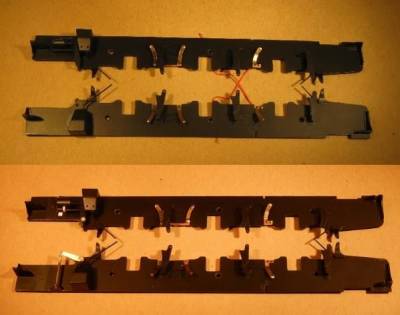 Frames before (above) and after extension
Frames before (above) and after extension
At the same time, I took the opportunity to add some detail to the steam brake on one side and to make a more realistic representation of the hand brake operating crank and spindle to replace the plastic component that was a bit distorted.
The plastic brake standard looked a bit undernourished so I made a replacement in brass and fitted it with a steel handle.
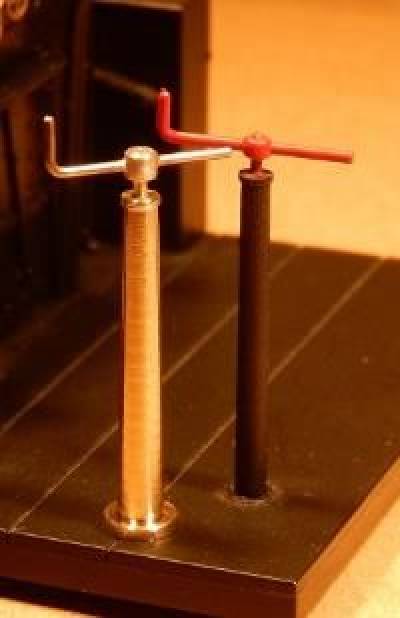 Replacement brake standard (left)
Replacement brake standard (left)
Next to be addressed were the steps, which required a bit of alteration to represent plain steps without the later additions of turn-ups to the treads.
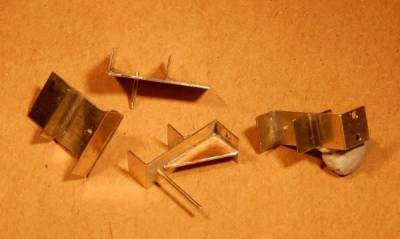 Nickel silver rear (left) and front step assemblies
Nickel silver rear (left) and front step assemblies
he rear steps are cast integrally with the running plate but I decided that it would be easiest to mill away most of the existing steps, leaving just a stub as a sturdy support, and to fit a new nickel silver step assembly on top.
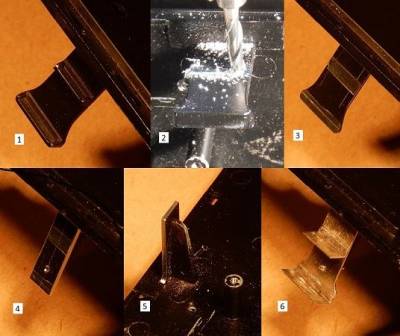 1) Original step 2) Milling away treads 3) Treads removed 4) Front of remaining stub 5) Rear of remaining stub 6) Replacement nickel silver step assembly superimposed on stub
1) Original step 2) Milling away treads 3) Treads removed 4) Front of remaining stub 5) Rear of remaining stub 6) Replacement nickel silver step assembly superimposed on stub
The front steps are supplied loose as optional additions that are intended to be glued below the running plate. I decided to make new assemblies in nickel silver that I could screw (2 x 12BA) below the running plate, after painting and lining.
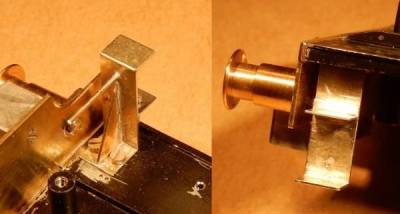 Replacement nickel silver front step assembly
Replacement nickel silver front step assembly
There were other smaller details that I elected to add or replace (samples shewn in the image below), including a lubricator (well, I think it is, difficult to tell from the photograph that I have) and a sand operating leaver that fit on the LHS within the frames towards the front, two boiler washout plugs for the firebox shoulders, four tapered handrail stanchions for the cab openings, two lamps (with lenses to be added after painting) and six lamp brackets that I silver soldered up from nickel silver strip.
I turned the reversing lever around on the quadrant because the release catch should be behind the leaver, as the driver looks at it. Given that it is already quite detailed and that it is well hidden within the closed cab, the only modification that I made to the backhead was to fit a valve handle on the LHS where there was a peculiar looking, oval blanking off plate. These components will appear in their places on the loco in later images.
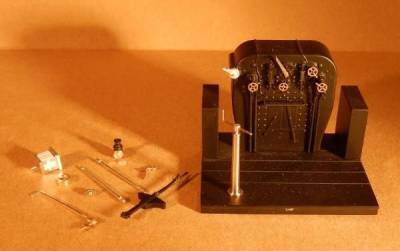 At this stage, I had ticked off all the tasks on my long list and the only remaining modification was to replace the upper part of the cab.
At this stage, I had ticked off all the tasks on my long list and the only remaining modification was to replace the upper part of the cab.
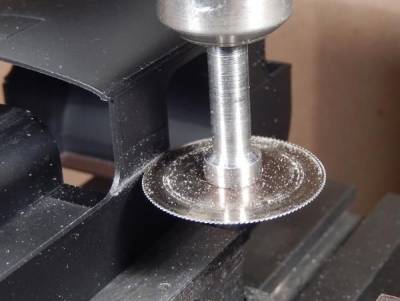 No going back now!
More to follow …
David
No going back now!
More to follow …
David
ThomasHeller - Wow, that's absolutely stunning … I'm very impressed by the neat work and also the perfect step by step documentation. I would be intersted to know, which speed for the mill you use, when cutting off the cab. Thomas
DLOS - hank you, Thomas. The slitting saw was running at 920 rpm, at which it seemed happy enough with light cuts and a slow feed rate. By using the countershaft, I could have taken it down to 130 rpm but then it would have been a longish job. David
Balchin20860 - Can I ask a stupidly obvious question - why the need for dumb buffers and conventional buffers on the same buffer beam (did the colliery not have modern rolling stock)?
DLOS - Not a stupid question, at all: I assume that all the Victory class locos originally had these dumb buffers when they were built in 1917 for dealing with chaldron wagons; they are shown on the drawings. Many industrial locos were fitted with two sets of buffers and, in later years, the evidence may have been the vestigial dropped buffer beams, often with the attachment holes for the erstwhile buffers still visible.
David
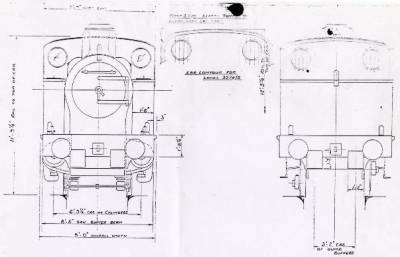 From The Railway Modeller, September 1966
From The Railway Modeller, September 1966
Balchin20860 - Thanks David - I have a very few dumb buffered LBSCR shingle ballast wagons but because of the unsatisfactory 'clunk' very rarely actually shunt with them (although they do at least line up with the position of the conventional buffers). Not seen any examples of both types on the same buffer beam at the same time before (must have made the shunters job a bit tricky as they would get clouted with his pole more often than not).
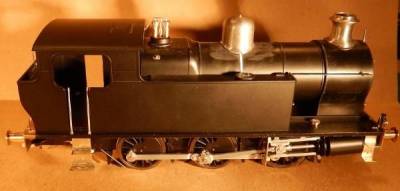 DLOS - So, as a recap, above is my Victory with all the redundant parts (except the upper part of the cab) removed and most of my mods and additions in place. All that remains to be done is to remove the upper part of the cab, which was a simple job with a slitting saw in the milling machine, and to fit a new one in brass.
DLOS - So, as a recap, above is my Victory with all the redundant parts (except the upper part of the cab) removed and most of my mods and additions in place. All that remains to be done is to remove the upper part of the cab, which was a simple job with a slitting saw in the milling machine, and to fit a new one in brass.
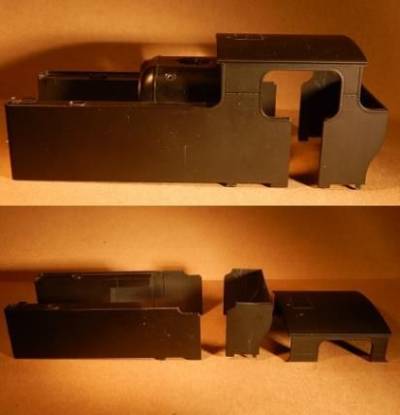 The tanks, cab and bunker moulding (above) and with the upper part of the cab removed (below).
The tanks, cab and bunker moulding (above) and with the upper part of the cab removed (below).
To measure up and fit the new upper part of the cab, I need to reassemble the major parts of the loco to create a KS Victory Cabriolet:
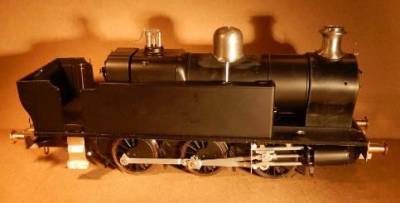 I made dimensioned sketches of the new front and rear cab sheets by referring to a drawing of a Hunslet Austerity with a Lambton cab and also with the aid of a cab etching of the same loco that was given to me by a friend who had built his Austerity with a conventional cab. Devising the dimensions of the two side sheets was a matter of fitting to the existing tanks and bunker, and referring to the photographs.
I made dimensioned sketches of the new front and rear cab sheets by referring to a drawing of a Hunslet Austerity with a Lambton cab and also with the aid of a cab etching of the same loco that was given to me by a friend who had built his Austerity with a conventional cab. Devising the dimensions of the two side sheets was a matter of fitting to the existing tanks and bunker, and referring to the photographs.
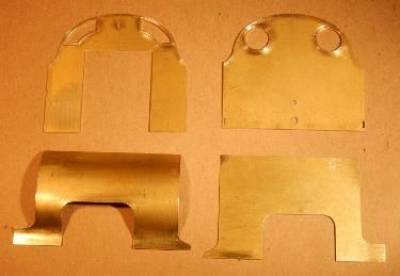 Components of the Lambton cab, one side sheet has been formed
The front and rear cab sheets fit neatly in place …
Components of the Lambton cab, one side sheet has been formed
The front and rear cab sheets fit neatly in place …
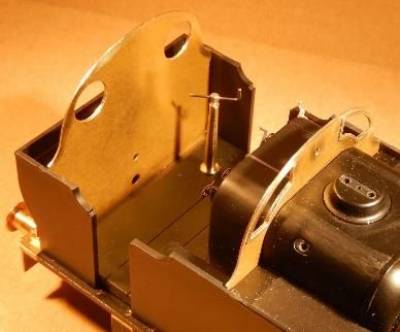 … all I have to do now is stick the side sheets on.
… all I have to do now is stick the side sheets on.
Nick Dunhill - Hi David Hang on, hang on, how did you make the window beading? That's the hardest bit of a model to make. Nick
DLOS - Gosh, Nick, a Red Letter Day - the day you ask me how to do something! For the rear cabsheet with the circular spectacles, I turned two suitable brass rings from an off-cut of 1/2” diameter brass bar, cleaned them up on the back with a smooth file and then soldered them in place on the cabsheet using my RSU. With a coping saw, I 'roughly' sawed out the material inside the rings to form the windows and then I carefully cleaned up to the rings with a half-round file. For the front cab sheet with the sort-of-crescent-like spectacles, I followed the same sort of idea. I marked out and 'roughly' sawed out one outline spectacle in 0.45mm brass sheet and I then soldered it back onto the sheet. Next, I sawed out the two blanks, following the rough outline of the first embryo spectacle, and then very carefully cleaned them up to my marking out with fine files. Reheating with a small blow torch allowed me to separate the two blanks, which needed a bit of cleaning up with a fine file on their inner edges.
I suppose the relatively important bit comes next: using a calliper, I deeply marked a line 0.8mm (I think it was) from the edges of each blank. From then on, it's pretty much as before, except that I had finally to saw through and file thicker material (0.45 + 0.7mm) to finish up with spectacles of uniform width and in the right place. Actually, with only photographs and without a drawing, I do not know that they are the right size and shape nor do I know that they are in exactly the right place - but I do know that they are near enough the same, which is all that matters (to me). Hope this helps. David
Actually, there was one more task that I had to undertake before soldering together the four elements of the cab, I needed to fit the bars to protect the glass in the rear windows, so it was fortunate that I looked at my schedule of tasks.
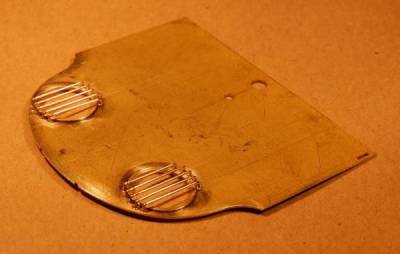 I found this not so easy to do. I had hoped to drill the holes using coordinates and my milling machine but, in the end, I found that marking out very carefully and drilling in stages up to 0.45mm to take the brass wire was likely to be the most successful way.
I found this not so easy to do. I had hoped to drill the holes using coordinates and my milling machine but, in the end, I found that marking out very carefully and drilling in stages up to 0.45mm to take the brass wire was likely to be the most successful way.
Oh, and just one more task: to make up the internal bunker, coal door and a few fittings.
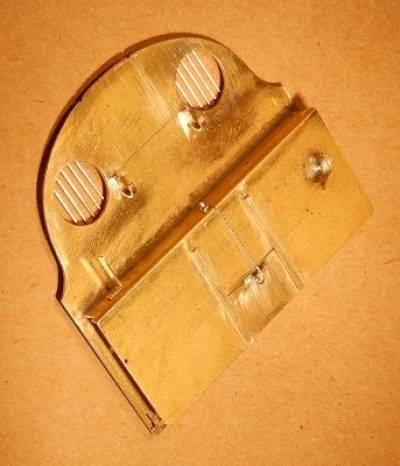 With the front and rear cab sheets slid into place in the grooves in the tanks and the bunker, respectively, I tacked on the left and right side sheets using my RSU. I carefully removed the assembly to finish the job with a conventional iron.
With the front and rear cab sheets slid into place in the grooves in the tanks and the bunker, respectively, I tacked on the left and right side sheets using my RSU. I carefully removed the assembly to finish the job with a conventional iron.
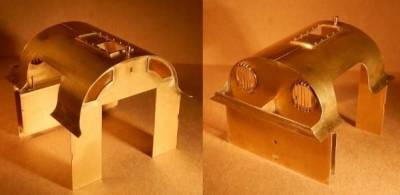 I finished off the assembly with a rear bunker extension and a ventilator in the roof.
I finished off the assembly with a rear bunker extension and a ventilator in the roof.
 As was planned (and hoped) the assembly slid back into place on the bunker and tanks and … ta-da … a Victory with a rather different looking cab.
More to follow … David
As was planned (and hoped) the assembly slid back into place on the bunker and tanks and … ta-da … a Victory with a rather different looking cab.
More to follow … David
Nick Dunhill - Top notch modelling. I cheated with my window bars and got a circular section etched with the drilling positions etched into it. Is the problem with drilling the holes with a drill in your mill the fact that tiny sub millimetre drills flex and wander off centre? I always find that when using a mini drill. I like your way of doing the window beading too. Nick.
DLOS - The ideal solution to the flexing is to use a stub drill. The fluted portion of these is about 1/3 the length of a normal jobbers' length bit, and (with the right sized chuck, this can mean the flexing tendency is lower by a factor of up to 27 (the flexing of a cantilever loaded at the end is proportional to l^3). Of course, using a hand-held mini-drill is far from ideal, and can give rise to other causes of deviation. A decent centre pop can help.
Alternatively, you can start each hole with a centre drill, but this involves a lot of swapping of drill bits, and rapidly becomes tedious.
Thank you, Nick No, I did use the mill to drill the holes but I had hoped to 'mark them out' using the dividing head on the mill and then to drill, all in one operation, but it was not so easy to set up a datum on the existing window openings. On the problems with sub millimetre sized drills, I think it might be worth repeating here what I have written a few times before because so many people have thanked me for the recommendation:
“… you really do need to use decent drills, not those inexpensive offerings commonly bought by modellers from a certain emporium or from a firm with a name that implies high social standing in a rural area.
I can thoroughly recommend the Drill Service www.drill-service.co.uk for all your drills, milling cutters and the like. They supply drills to industry so their website is massive (a first visit is a bit like walking into a London department store when you are used to the village shop), they are happy to supply a single drill but it is worth making up an order for £10 for free p&p, order online.
You are after HSS jobber drills https://www.drill-service.co.uk/Product.asp?Parent=020080440000&Tool=394 but don't frighten yourself with the you-cannot-be-serious tiny drills at the top of the page; a 0.5mm drill is £1.68.
HSS centre drills are at: https://www.drill-service.co.uk/Product.asp?Parent=040020060020&Tool=720 one with a 0.5mm pilot diameter is £3.91.
A poorly supported job and a soft, bendy drill is a recipe for failure so clamp the job in a vice (x-y makes positioning extremely easy, but it's not essential), spot a hole with a centre drill and follow up with the 0.5mm drill using a drill press with a sturdy quill and running at an appropriate speed (ie quite fast, say 4000rpm or more). I use a bit of spit as a cutting fluid, although traditionally brass is cut dry.
I hope this helps you on your way and you do not spend any more of your leisure time breaking drills! Cheers, David
OK, Chris and Chris, it’s safe to come out from behind the settee and to open your eyes again now:
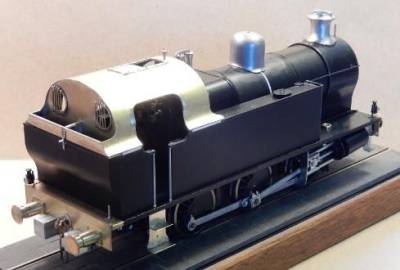
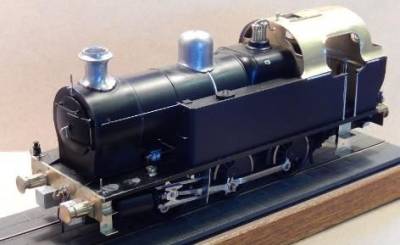 I have ticked off the last of the tasks from my list and No. 41 will soon be off to the paint shop. However, before that, I put in place nearly all the loose bits that will not be permanently attached until after painting and took these two photographs.
David
I have ticked off the last of the tasks from my list and No. 41 will soon be off to the paint shop. However, before that, I put in place nearly all the loose bits that will not be permanently attached until after painting and took these two photographs.
David





